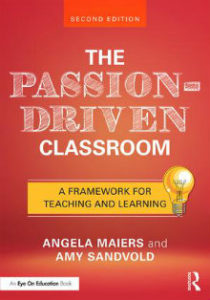A Guide to Encouraging Passion-Based Learning
The Passion-Driven Classroom: A Framework for Teaching and Learning
By Angela Maiers and Amy Sandvold
(Routledge/Eye On Education, 2018 – Learn more)

When is the last time your students were excited about their learning? The Passion-Driven Classroom presents a mindset that focuses on student strengths and interests as a pathway to success. Authors Angela Maiers and Amy Sandvold challenge readers to rethink their educational framework and consider a student-centered, passion-focused approach to learning.

• Perseverance
• Action-Driven
• Strength-Building
• Sustainable
• Inquisitive
• Ownership
• Never-Ending
Beyond compliance
Existing models of compliance don’t provide the ownership and voice and choice that students need. Traditional models also don’t equip students with the skills and dispositions that future employers are seeking. From the Clubhouse Mindset to the Expert Wall to the Passion Discovery Continuum, the authors provide multiple opportunities for educators to experiment with passion-driven learning in the classroom.
Ideas aligned with the middle school model
The ideas shared within the book are certainly applicable to all grades and subject areas, but seem particularly aligned with the middle school model and the needs of adolescent learners to explore their passions and take ownership over their learning.
Chapter 5 in particular provides valuable information about classroom environment, routines, procedures, and tools. This discussion is critical for any teacher getting started with passion-based learning or any number of other empowering classroom initiatives. The advice is relevant to educators who are exploring flexible seating or adding opportunities for hands-on learning and is practical for those who are looking at instruction through a new lens.
Putting “You Matter” into action
The book also highlights Maiers’ powerful You Matter movement, emphasizing the importance of recognizing students and finding ways to support their efforts each day. She offers meaningful ways to embed this work into the school day so that students are valued.
The authors provide a lot of direct connections to English Language Arts content with student “think books” and the HEART technique for analyzing texts. They also share lists of supporting children’s literature and simple ELA strategies for classroom use.
A balance between the why and the how
In Chapter 6, tips for classroom management and a variety of lesson plan ideas are shared. The book strikes a nice balance between the why and the how of incorporating passion-based learning into classroom practices.
One concept that I really connected with was the difference between doing and being, particularly when it comes to assessment and grading. What students DO and what they will BE are very different. Students can DO a written report. They can cite sources and include references. They can DO a homework packet, but what we want them to develop and BE is far more important. Will your students BE inquisitive? Caring? Confident? Collaborative? This is one aspect of the book that deserves a lot of consideration.
Maiers and Sandvold provide a great resource for educators who embrace the student-centered focus of passion-based learning. Their book emphasizes this pathway as a means to help students stay passionate, use their passion in the classroom, and become more passionate about gaining knowledge, skills and understanding.
Though focused on the student learner, this book might also be an opportunity for educators to consider their own passions and use them to enhance classroom instruction.
Jacie Maslyk has served in public education for 21 years and is currently the Assistant Superintendent in the Hopewell Area School District in Pennsylvania. Awarded the Frank S. Manchester Award for Excellence in Journalism, she is the author of STEAM Makers: Fostering Creativity and Innovation in Elementary Classrooms (Corwin Press, 2016). She is also a blogger, keynote speaker, and educational consultant sharing her work at STEAM-Makers.com.



































Thank you for your thought-filled comments and what connected with you! You made my day! Amy Sandvold